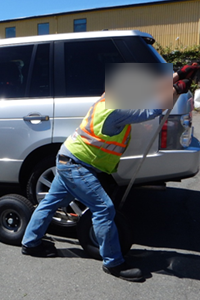Worker died after being struck by dolly lifting system’s pry bar
Although this photograph does not portray the incident scene, the worker in this photograph is using the pry bar in a manner similar to the way it was being used at the time of the incident. The slight bend in the pry bar indicates the force needed to hold it in this ratchet position.
Date of incident: June 2019
Notice of incident number: 2019139860034
Employers: Auto towing companies (one contracted by the other)
Incident summary
A worker was preparing to tow a vehicle from the underground parking garage of a residential building. The rear of the vehicle was parked close to a wall. Using a wheel dolly lifting system, the worker lifted the dolly under the passenger-side rear tire of the vehicle, with one passenger-side dolly wheel in front of the tire and the other passenger-side dolly wheel behind the tire. Next, the worker lifted the third dolly wheel in front of the driver-side rear tire, and then attempted to lift the fourth dolly wheel behind the driver-side rear tire. When the worker was pushing the dolly’s pry bar from either the second ratchet position to the third or from the third position to the fourth, the worker was positioned over the pry bar. The pry bar sprang out of the worker’s grasp and struck him. The worker sustained fatal injuries.
Investigation conclusions
Cause
- Wrong lifting sequence. The vehicle to be towed was parked close to a wall and the last of the four dolly wheels to be lifted into towing position was next to the wall. Much of the vehicle’s weight was on that portion of the dolly lifting system. The lifting sequence used was contrary to the one recommended by the manufacturer for safe operation of the dolly on a vehicle parked against a wall. The manufacturer recommends first lifting the dolly wheel closest to the wall to the second ratchet position, then the other wheel of that side of the dolly lifting system (in front of the tire) to the fifth ratchet position. Using the recommended lifting sequence would likely have prevented the incident.
Contributing factors
- Lack of safe work procedures. The auto towing company that contracted the worker’s employer failed to provide safe work procedures for the operation of the dolly lifting system. Specifically, such work procedures could have been developed to identify and address specific hazards related to setting up the dolly close to an obstruction such as a wall. They could also have incorporated the manufacturer’s recommended procedures or alternative safe work methods.
- Inadequate training. The company that contracted the worker’s employer did not have in place an adequate training program for new or experienced drivers, including contractors. Adequate worker training, including in safe work procedures, would have been a way to ensure workers were aware of all known or reasonably foreseeable hazards associated with operating the dolly lifting system and to ensure the health and safety of any workers present where the company’s work was being carried out.
Other safety issues
- Both employers lacked work procedures for inspection and maintenance of the dolly lifting system. For safe use of the dolly, the manufacturer recommends that a visual inspection of all dolly components be carried out prior to using the dolly. The manufacturer also provides guidelines for monthly, quarterly, and seasonal inspections and maintenance. The investigation did not identify this factor as having contributed to the incident. However, failure to inspect and maintain equipment could pose a risk of a serious incident occurring.

